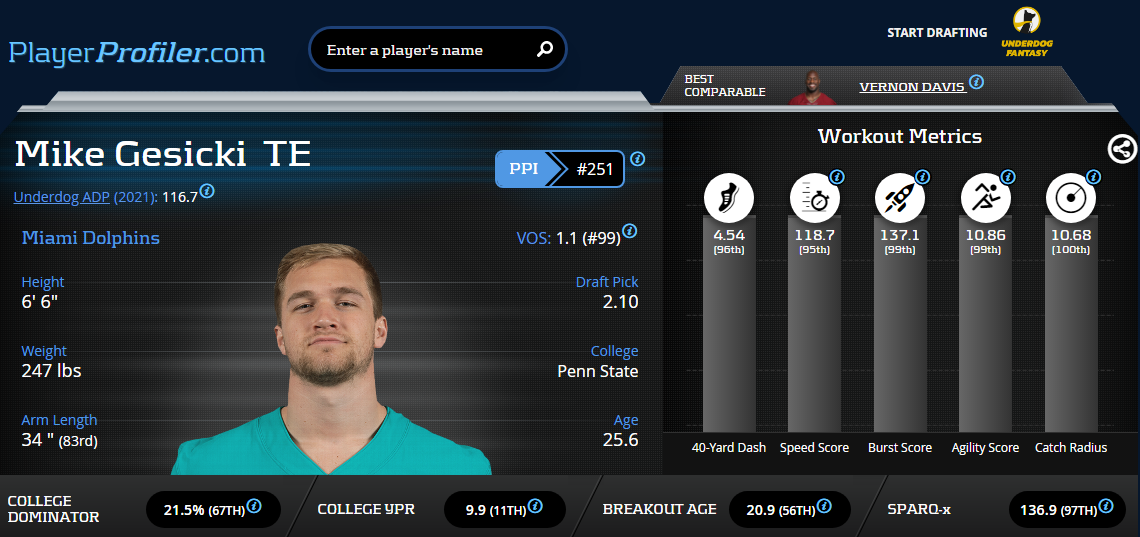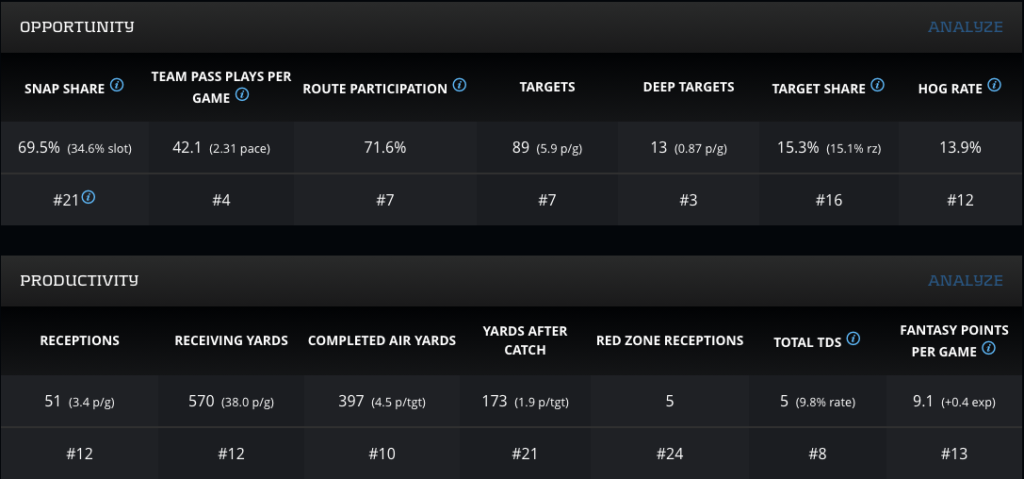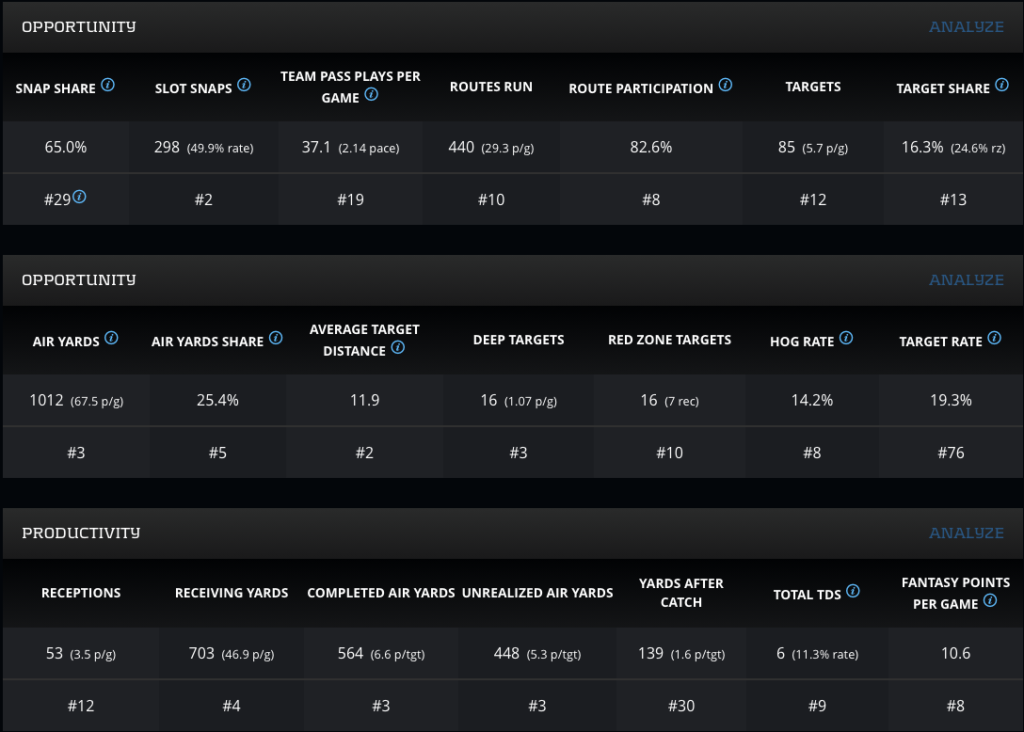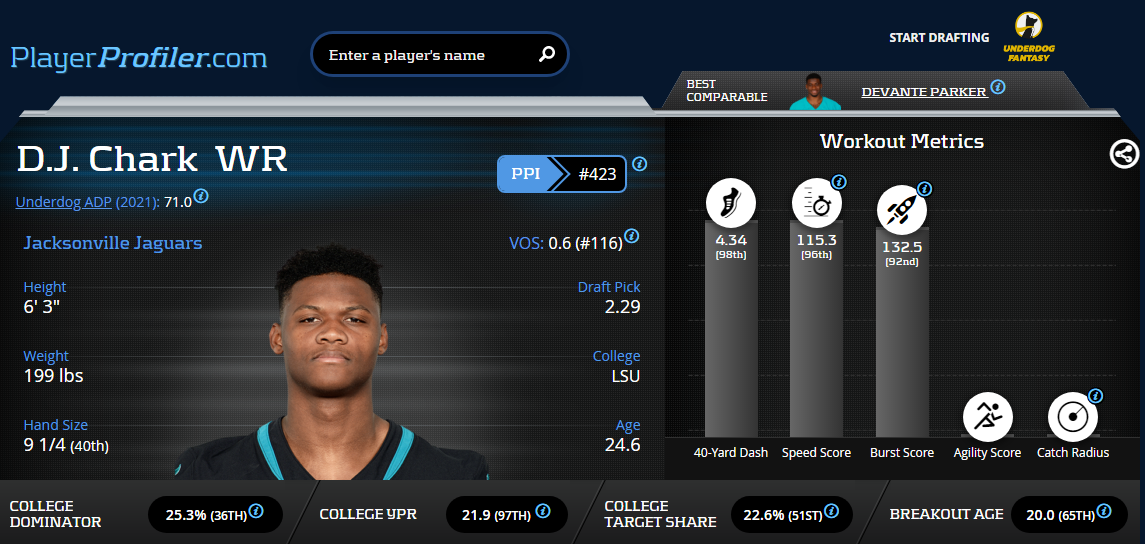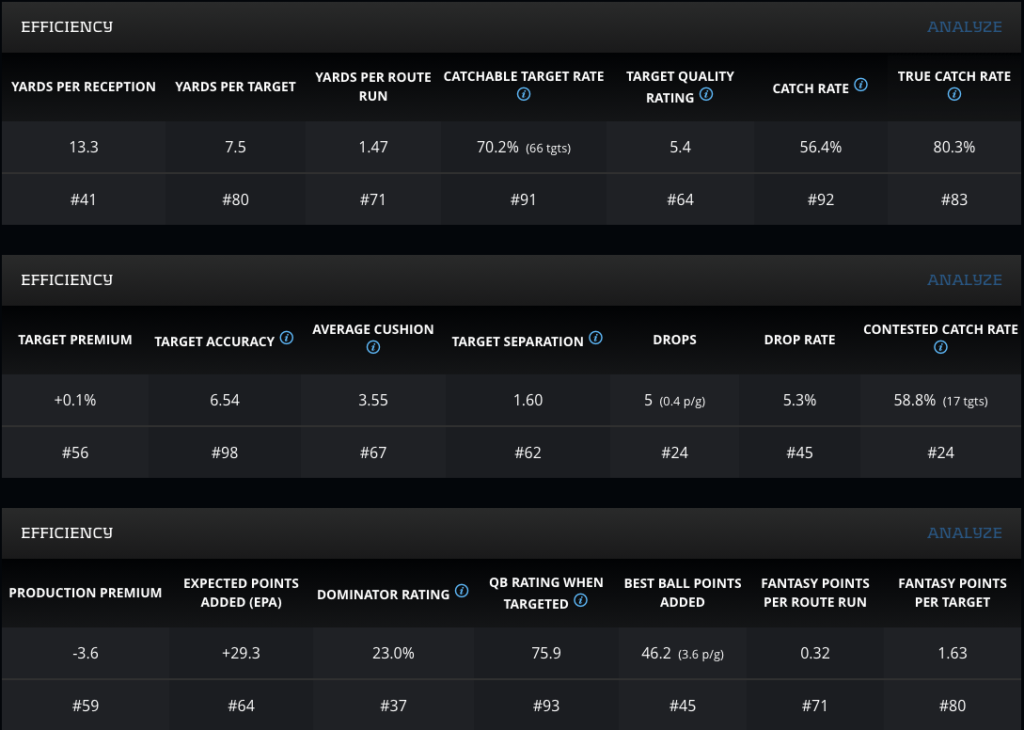We all have them. The players we attach ourselves to over the course of the pre-draft process. The ones we try our damnedest to draft or acquire in fantasy football. For better or worse, these are the players we end up attaching our reputations to as fantasy players and/or analysts. This series will focus on both sides of that particular coin.
In this new Underworld venture called Studs and Duds, we will talk about one player we planted our proverbial flag on that was a hit and one that was a bust. Along the way, we’ll be using PlayerProfiler’s advanced stats, metrics and analytics to analyze the process, figure out how and why these players hit/busted, and decide whether we want to target/fade said players next season.
Volume 6 – Matt Babich
Stud: Mike Gesicki
The tight end position has a slow learning curve. Piling that onto Mike Gesicki’s misusage through his first season and a half at the NFL level, and it’s clear that he didn’t have much of a chance to succeed. I sowed the seeds of the athletic tight end, bought in early on his potential, and reaped the benefits.
How Many Leagues Did You Have Him In?
Late-round tight end has been a fantasy philosophy of mine since I started playing the game. I never saw the need to spend up. In 2020, Mike Gesickibecame my late-round love. I grabbed him in three of my four redraft leagues and in one of two dynasty leagues. Gesicki made the biggest impact from my diverse sleeper tight end portfolio, headlining my two 2020 championship rosters.
When Did You Know He Was One of Your Guys?
I fell in love with Mike Gesicki’s athleticism in the 2018 offseason. I was still new to PlayerProfiler content, so his profile was a surprise to me. Gesicki is one of only six tight ends to rank in the 90th-percentile or higher in all Workout Metrics PlayerProfiler features for the position. The other members of this exclusive club are Vernon Davis, Noah Fant, George Kittle, Dustin Keller, and Moritz Boehringer.
Near the exact same frame, Gesicki measures better than rookie sensation Kyle Pitts. Elite athleticism and weight-adjusted agility, two highly predictive factors for tight end breakouts, combined with his frame and the potential opportunity in Miami made him the apple of my eye.
Why Did You Like Him So Much?
Despite a 65.0-percent (No. 29 among qualified tight ends) Snap Share in 2019, Mike Gesicki dominated Miami’s Target Share and put up impressive opportunity and productivity metrics over the course of the season, seeing an impressive volume of 867 (No. 5) Air Yards, 13 (No. 3) Deep Targets, and five (No. 8) Total Touchdowns. He began to break out over the last nine weeks of 2019, logging a 75.54-percent (No. 10 among season-long finishers) Snap Share and finishing with four top 10 performances. During this stretch, he averaged 11.74 (No. 8 over that span) Fantasy Points Per Game. Following his breakout performances in the 2019 season, the stars began to align with the firing of Adam Gase and drafting of Tua Tagovailoa.
Gesicki checked all the boxes necessary to be a late round tight end target: opportunity in a high volume passing offense, bountiful athleticism, and prior NFL production.
Gesicki, along with the entire Dolphins offense, struggled at points last season while they battled cohesion issues at the quarterback position. Despite this, he still saw monster usage rates and produced when called upon, finishing with 10.6 (No. 8) Fantasy Points per Game. He ran 440 (No. 10) Routes and saw 298 (No. 2) Slot Snapsen route to a 25.4-percent (No. 5) Air Yards Share, 14.2-percent (No. 8) Hog Rate, and 21.8-percent (No. 7) Dominator Rating.
This is the tip of the iceberg for Gesicki. Prior to missing Week 12 with a thumb injury, Tagovailoa averaged 23.75 Pass Attempts per Game. When he returned in Week 13, that number rose to 38.6 Pass Attempts per Game over the remainder of the season. During that stretch, Gesicki was the TE4. He averaged 16.6 Fantasy Points per Game despite missing Week 15 and playing through a shoulder dislocation and labral tear (a gruesome injury to play through) during the last two weeks.
What Did You Learn?
The success of Mike Gesicki and other late-round tight ends last seasonconfirmed the process of fading the average draft positions outside of the “Big Three.” Past Travis Kelce, George Kittle, and Darren Waller, the Fantasy Points per Gamedifferential between TE1’s will be within two to three points per game.
Buying early into a small differential carries a heavy opportunity cost. Those who went against this logic and drafted the likes of Zach Ertz, Evan Engram, or Hayden Hurst pleaded for a do-over, while those who had Gesicki, T.J. Hockenson, Robert Tonyan, and Logan Thomas celebrate their top 10 finishes.
Where Would You Be Comfortable Drafting Him in 2021?
In 12-team leagues, Mike Gesicki’s Underdog ADP is in the mid-tenth round at pick 116.7 (TE11). I love this spot for a guy who had 41.2 (No. 6) Best Ball Points Added in 2020. This season, especially in Underdog, at least one tight end in the tier of T.J. Hockenson, Dallas Goedert, Logan Thomas,Robert Tonyan, and Gesicki should be targeted for an optimal positional build. While Gesicki’s ADP will see a marginal rise in PPR leagues, he will be the cheapest option in this tier in any format. He showed great chemistry with Tua Tagovailoain the back half of 2020 and will still see ample opportunity next season. I will be grabbing Gesicki as often as I can, and my flag will remain firmly planted.
Dud: D.J. Chark
D.J. Charkhad an incredible breakout season in 2019, averaging 14.9 (No. 19) Fantasy Points per Game in an anemic offense led by rookie Gardner Minshew. Jacksonville’s passing struggles worsened in 2020, and Chark’s production went down with the ship.
How Many Leagues Did You Have Him In?
There was no player I talked up more last season than D.J. Chark, so this is still a fresh wound for me. I loved his mid-fifth to mid-sixth round ADP range, drafting him in three of my four redraft leagues. I failed to grab him in any dynasty leagues.
When Did You Know He Was One of Your Guys?
D.J. Charklacked production in a run-heavy LSU offense, but his frame and athleticism were enough to get him second round draft capital. His 4.34 (98th-percentile) 40-yard Dash, 115.3 (96th-percentile) Speed Score, and 132.5 (92nd-percentile) Burst Score are phenomenal for a wide receiver.
Chark stole the show in 2019, racking up 73 (No. 19) receptions, 1,008 (No. 24) receiving yards, eight (No. 8) Total Touchdowns, and recording a 31.4-percent (No. 13) Dominator Rating. What’s more eye-opening is that he commanded a 1,452 (No. 20) Total Target Distance and 725 were Unrealized Air Yards. He proved there was potential for him to accomplish even more in this offense.
Why Did You Like Him So Much?
I’m a proponent of drafting three running backs within the first four rounds whenever possible, due to the scarcity of the position and the talent pool of receivers that are typically found within rounds four through eight or later. In this range, you want to target receivers with high ceilings in high volume passing offenses that can command a significant Opportunity Share. D.J. Chark showed a high ceiling with four games of double digit targets, two games over 140 yards, and two games over 30 fantasy points with subpar quarterback play. All Gardner Minshewneeded to do was provide him with higher quality targets.
My belief in the Mustached Maestro, however, was misplaced. Chark’s 70.2-percent (No. 91) Catchable Target Rate, 5.4 (No. 64) Target Quality Rating, and 6.54 (No. 98) Target Accuracy were abysmal. His production was crippled by Minshew’s inability to provide him with fantasy relevant targets, shown in his +0.1-percent (No. 56) Target Premium. Once again, he showed that he is capable of much more production, seeing another disappointing sum of 756 (No. 9) Unrealized Air Yards out of 1,300 (No. 19) actual Air Yards. Health also played a role in his disappointing season. He missed three games while suffering chest and back injuries in Week 2, an ankle sprain in Week 5, a rib in jury in Week 11, and a shin injury in Week 16. At many points in the season, it was clear that he was playing through pain.
What Did You Learn?
Quarterback play was a factor I did not consider enough when drafting wide receivers in 2020. I valued D.J. Chark over the likes of Will Fullerand Stefon Diggs. This was bad process, and my most fatal error. If a receiver like Chark can only attain quality targets in shallow ranges, it will be difficult for him to produce. The takeaway here is to prioritize those who have a supporting cast that is more capable of pushing that player to his ceiling when targeting mid-round receivers. Will Fuller, paired with Deshaun Watson and little target competition,was last season’s perfect example.
Where Would You Be Comfortable Drafting Him in 2021?
Trevor Lawrence is assumedly the future sheriff in Jacksonville, which will drastically improve D.J. Chark’s Target Quality. While Marvin Jones is now a Jaguar and Laviska Shenaultlooks to expand on his rookie production, there are still 153 vacated targets from the departures of Keelan Cole and Chris Conley. I still believe in Chark, but I have an abundance of caution at his projected ADP.
DJ Chark had 5+ Targets in 10 of 13 games in 2020 ? pic.twitter.com/6K88AW0TOI
— RotoUnderworld (@rotounderworld) March 24, 2021
I love Shenault, going a round later on average, too much to go all in on Chark this offseason. In his mid-round range I prefer to either grab a receiver such as Courtland Suttonor Will Fuller, or a different position altogether. Depending on how drafts shake up I may own redraft shares of Chark in 2021, but I will be slow to buy.


